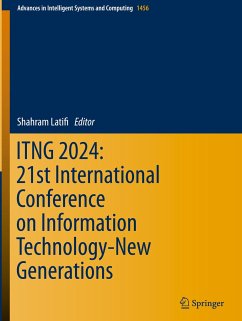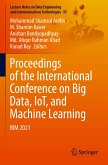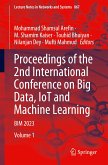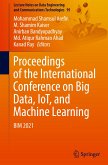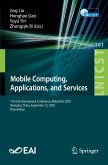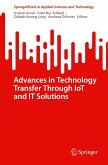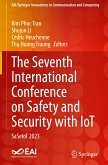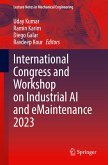ITNG 2024: 21st International Conference on Information Technology-New Generations
Herausgegeben:Latifi, Shahram
ITNG 2024: 21st International Conference on Information Technology-New Generations
Herausgegeben:Latifi, Shahram
- Gebundenes Buch
- Merkliste
- Auf die Merkliste
- Bewerten Bewerten
- Teilen
- Produkt teilen
- Produkterinnerung
- Produkterinnerung
This volume represents the 21st International Conference on Information Technology - New Generations (ITNG), 2024. ITNG is an annual event focusing on state of the art technologies pertaining to digital information and communications. The applications of advanced information technology to such domains as astronomy, biology, education, geosciences, security, and health care are the among topics of relevance to ITNG. Visionary ideas, theoretical and experimental results, as well as prototypes, designs, and tools that help the information readily flow to the user are of special interest. Machine…mehr
Andere Kunden interessierten sich auch für
![Proceedings of the International Conference on Big Data, IoT, and Machine Learning Proceedings of the International Conference on Big Data, IoT, and Machine Learning]() Proceedings of the International Conference on Big Data, IoT, and Machine Learning220,99 €
Proceedings of the International Conference on Big Data, IoT, and Machine Learning220,99 €![Proceedings of the 2nd International Conference on Big Data, IoT and Machine Learning Proceedings of the 2nd International Conference on Big Data, IoT and Machine Learning]() Proceedings of the 2nd International Conference on Big Data, IoT and Machine Learning191,99 €
Proceedings of the 2nd International Conference on Big Data, IoT and Machine Learning191,99 €![Proceedings of the International Conference on Big Data, IoT, and Machine Learning Proceedings of the International Conference on Big Data, IoT, and Machine Learning]() Proceedings of the International Conference on Big Data, IoT, and Machine Learning220,99 €
Proceedings of the International Conference on Big Data, IoT, and Machine Learning220,99 €![Mobile Computing, Applications, and Services Mobile Computing, Applications, and Services]() Mobile Computing, Applications, and Services41,99 €
Mobile Computing, Applications, and Services41,99 €![Advances in Technology Transfer Through IoT and IT Solutions Advances in Technology Transfer Through IoT and IT Solutions]() Advances in Technology Transfer Through IoT and IT Solutions37,99 €
Advances in Technology Transfer Through IoT and IT Solutions37,99 €![The Seventh International Conference on Safety and Security with IoT The Seventh International Conference on Safety and Security with IoT]() The Seventh International Conference on Safety and Security with IoT103,99 €
The Seventh International Conference on Safety and Security with IoT103,99 €![International Congress and Workshop on Industrial AI and eMaintenance 2023 International Congress and Workshop on Industrial AI and eMaintenance 2023]() International Congress and Workshop on Industrial AI and eMaintenance 2023183,99 €
International Congress and Workshop on Industrial AI and eMaintenance 2023183,99 €-
-
-
This volume represents the 21st International Conference on Information Technology - New Generations (ITNG), 2024. ITNG is an annual event focusing on state of the art technologies pertaining to digital information and communications. The applications of advanced information technology to such domains as astronomy, biology, education, geosciences, security, and health care are the among topics of relevance to ITNG. Visionary ideas, theoretical and experimental results, as well as prototypes, designs, and tools that help the information readily flow to the user are of special interest. Machine Learning, Robotics, High Performance Computing, and Innovative Methods of Computing are examples of related topics. The conference features keynote speakers, a best student award, poster award, service award, a technical open panel, and workshops/exhibits from industry, government and academia. This publication is unique as it captures modern trends in IT with a balance of theoretical and experimental work. Most other work focus either on theoretical or experimental, but not both. Accordingly, we do not know of any competitive literature.
Produktdetails
- Produktdetails
- Advances in Intelligent Systems and Computing 1456
- Verlag: Springer / Springer Nature Switzerland / Springer, Berlin
- Artikelnr. des Verlages: 978-3-031-56598-4
- 2024
- Seitenzahl: 552
- Erscheinungstermin: 9. Juli 2024
- Englisch
- Abmessung: 285mm x 215mm x 34mm
- Gewicht: 1650g
- ISBN-13: 9783031565984
- ISBN-10: 3031565983
- Artikelnr.: 69968787
- Herstellerkennzeichnung Die Herstellerinformationen sind derzeit nicht verfügbar.
- Advances in Intelligent Systems and Computing 1456
- Verlag: Springer / Springer Nature Switzerland / Springer, Berlin
- Artikelnr. des Verlages: 978-3-031-56598-4
- 2024
- Seitenzahl: 552
- Erscheinungstermin: 9. Juli 2024
- Englisch
- Abmessung: 285mm x 215mm x 34mm
- Gewicht: 1650g
- ISBN-13: 9783031565984
- ISBN-10: 3031565983
- Artikelnr.: 69968787
- Herstellerkennzeichnung Die Herstellerinformationen sind derzeit nicht verfügbar.
Shahram Latifi, an IEEE Fellow (2002), received the Master of Science and the PhD degrees both in Electrical and Computer Engineering from Louisiana State University, Baton Rouge, in 1986 and 1989, respectively. He is currently a Professor of Electrical Engineering at the University of Nevada, Las Vegas. Dr. Latifi is the co-director of the Center for Information Technology and Algorithms (CITA) at UNLV. He has designed and taught undergraduate and graduate courses in the broad spectrum of Computer Science and Engineering in the past four decades. He has given keynotes and seminars on machine learning/AI and IT-related topics all over the world. He has authored over 250 technical articles in the areas of networking, cybersecurity, image processing, biosurveillance, biometrics, document analysis, fault tolerant computing, parallel processing, and data compression. His research has been funded by NSF, NASA, DOE, DoD, Boeing, Lockheed and Cray Inc. Dr. Latifi was an Associate Editor of the IEEE Transactions on Computers (1999-2006), an IEEE Distinguished Speaker (1997-2000), and Co-founder and General Chair of the IEEE Int'l Conf. on Information Technology (2004-2015). Dr. Latifi is the recipient of several research awards, the most recent being the Barrick Distinguished Research Award (2021). Dr. Latifi was recognized to be among the top 2% researchers around the world in December 2020, according to Stanford top 2% list (publication data in Scopus, Mendeley). He is a Registered Professional Engineer in the State of Nevada.
Part I. AI and Robotics.- 1. Projecting Elliott patterns in different degrees of waves for analyzing financial market behavior.- 2. An Integration of Blockchain Web3 and Robotic Process Automation for Property Ownership Traceability.- 3. Early identification of conflicts in the Chilean fisheries and aquaculture sector using text mining and machine learning techniques.- 4. Enhanced AES for Securing Hand Written Signature using Residue Number System.- 5. Using GPT-4 to Tutor Technical Subjects in non English Languages in Africa.- Part II. Cybersecurity.- 6. A Practical Survey of Data Carving from Non-Functional Android Phones Using Chip-Off Technique.- 7. Automated Semantic Role Mining using Intelligent Role Based Access Control in Globally Distributed Banking Environment.- 8. Software Bill of Materials (SBOM) Approach to IoT Security Vulnerability Assessment.- 9. AI-Assisted Pentesting Using ChatGPT-4.- 10. Combining Cyber Security and Data Science: A Cutting-Edge Approach for Public Health Education Masters.- 11. Integrating Intelligence Paradigms into Cyber Security Curriculum for Advanced Threat Mitigation.- 12. Simulation Tests in Anti-phishing Training.- 13. Where is our data and how is it protected?.- 14. SIV-MAC: an efficient MAC scheme.- 15. Speeding up RSA signature verification.- 16. A Comparative Analysis on Ensemble Learning and Deep Learning Based Intrusion Detection Systems Over the NCC2 Dataset.- 17. Innovative Lightweight Key Agreement Protocol Based on Hyperelliptic Curve for IoT Mutual Authentication.- 18. SECURITY ANALYSIS OF DRONE COMMUNICATION METHODS.- 19. AI and Democracy: A Human Problem.- 20. Comparative study of the Clarity of Privacy Policies in Social Media.- 21. ClipSecure: Addressing Privacy and Security Concerns in Android Clipboard.- 22. Security Vulnerabilities in Facebook Data Breach.- 23. Intelligent Intrusion Detection Model with MapReduce and Deep Learning Model.- 24. Ethical Considerations in the Development and Use of AI WeaponSystems.- 25. Cyber Attack Intensity Prediction Using Feature Selection and Machine Learning Models.- 26. Analysis of IoT Vulnerabilities and Proposed Solution Approach for Secure Real-Time IoT Communication.- 27. Blockchain Based Identity Management For Secure Data Sharing.- Part III. Data Science.- 28. Case Study of an Interdisciplinary Academic Project for Reading Fluency Analysis.- 29. Strategic Software Modernization: Business-IT Convergence with Large Language Model.- 30. Feature Fusion Approach for Emotion Classification in EEG Signals.- 31. Household Discovery with Group Membership Graphs.- 32. Initial Design and Implementation of an Edge-to-Edge LoRaWAN Data Collection System.- 33. A study on data quality and analysis in Business Intelligence.- 34. Exploring the Impact of Augmented Reality Applications on Student Engagement in Higher Education in South Africa: A Review.- Part IV. Human-Computer Interaction.- 35. TickTrax: A Mobile and Web-Based Application for Tick Monitoringand Analysis.- 36. Developing students' reflective skills to improve the learning of Human-Computer Interaction.- 37. Options Matter: Exploring VR Input Fatigue Reduction.- 38. Introductory Pathway to Virtual Reality by Developing Immersive Games of Skill.- 39. A User Study of Two Downstream single-cell Data Analysis Methods: Clustering and Trajectory Inference.- 40. Fostering Joint Innovation: A Global Online Platform for Idea Sharing and Collaboration.- 41. Keep Sailing: An Investigation of Effective Navigation Controls and Subconscious Learning in Simulated Maritime Environment.- Part V. Machine Learning: Theory & Applications.- 42. Offense Severity Prediction Under Partial Knowledge: Trigger Factor Detection Using Machine Learning and Network Science Methods.- 43. Exploring Deep Learning Techniques in the Prediction of Cancer Relapse using an Open Brazilian Tabular Database.- 44. A Review of the Use of Machine Learning for Pharmaceutical Formulations.- 45. A Method for Improving the Recognition Accuracy of Pattern Classification.- 46. An Application of Support Vector Machine, Random Forest, and Related Machine Learning Algorithms on California Wildfire Data.- 47. GPU-accelerated neural networks and computational strategies to predict wave heights.- Part VII. Software Engineering.- 48. A method based on Behavior Driven Development (BDD) and System-Theoretic Process Analysis (STPA) for verifying security requirements in critical software systems.- 49. JSON and XML schemas for WebSTAMP.- 50. Elements-Based Test Suite Reduction for Android Test Suites Generated by Reinforcement Learning.- 51. Towards Adopting a Digital Twin Framework (ISO 23247) for Battery Systems.- 52. Challenges and Success Factors in Large Scale Agile Transformation - A Systematic Literature Review.- 53. Integrating AIaaS into existing systems: the Gokind experience.- 54. A Novel Implementation of FHUQI-Miner, TKQ and FCHM Algorithms for High-Utility Itemset Mining to Predict User Behavior UsingSmartphone Context Events.- 55. Towards systematic and precise compilation of domain-specific modelling languages.- Part VI. Potpourri.- 56. A Detection Method for Circumferential Alignment of Diminutive Lesions Using Wavelet Transform Modulus Maxima and Higher-Order Local Autocorrelation.- 57. Impedance Analysis of Adaptive Distance Relays using Machine Learning.- 58. Employees´ experiences of using a mobile health application: A qualitative study based on digital intervention.- 59. MicroSTAMP: microservices for steps 1 and 2 of the System-Theoretic Process Analysis (STPA) technique.- 60. The Disparate Impact of Distinct Background Music on Gameplay Experience: An Empirical Analysis.- 61. Triangulation Guided High Clearance Paths.- 62. Towards Visualizing the Status of Bug Reports.- 63. Quarantine Centrality: Principal Component Analysis of SIS Model Simulation Results to Quantify the Vulnerability of Nodes to Stay Infected in Complex Networks.- 64. A holistic approach for single-cell data trajectory inference using chromosome physical location and ensemble random walk.- 65. Graph partitioning algorithms: a comparative study.- 66. 3D Video Game Simulation Based on Colored Petri net and SIMIO.
Part I. AI and Robotics.- 1. Projecting Elliott patterns in different degrees of waves for analyzing financial market behavior.- 2. An Integration of Blockchain Web3 and Robotic Process Automation for Property Ownership Traceability.- 3. Early identification of conflicts in the Chilean fisheries and aquaculture sector using text mining and machine learning techniques.- 4. Enhanced AES for Securing Hand Written Signature using Residue Number System.- 5. Using GPT-4 to Tutor Technical Subjects in non English Languages in Africa.- Part II. Cybersecurity.- 6. A Practical Survey of Data Carving from Non-Functional Android Phones Using Chip-Off Technique.- 7. Automated Semantic Role Mining using Intelligent Role Based Access Control in Globally Distributed Banking Environment.- 8. Software Bill of Materials (SBOM) Approach to IoT Security Vulnerability Assessment.- 9. AI-Assisted Pentesting Using ChatGPT-4.- 10. Combining Cyber Security and Data Science: A Cutting-Edge Approach for Public Health Education Masters.- 11. Integrating Intelligence Paradigms into Cyber Security Curriculum for Advanced Threat Mitigation.- 12. Simulation Tests in Anti-phishing Training.- 13. Where is our data and how is it protected?.- 14. SIV-MAC: an efficient MAC scheme.- 15. Speeding up RSA signature verification.- 16. A Comparative Analysis on Ensemble Learning and Deep Learning Based Intrusion Detection Systems Over the NCC2 Dataset.- 17. Innovative Lightweight Key Agreement Protocol Based on Hyperelliptic Curve for IoT Mutual Authentication.- 18. SECURITY ANALYSIS OF DRONE COMMUNICATION METHODS.- 19. AI and Democracy: A Human Problem.- 20. Comparative study of the Clarity of Privacy Policies in Social Media.- 21. ClipSecure: Addressing Privacy and Security Concerns in Android Clipboard.- 22. Security Vulnerabilities in Facebook Data Breach.- 23. Intelligent Intrusion Detection Model with MapReduce and Deep Learning Model.- 24. Ethical Considerations in the Development and Use of AI WeaponSystems.- 25. Cyber Attack Intensity Prediction Using Feature Selection and Machine Learning Models.- 26. Analysis of IoT Vulnerabilities and Proposed Solution Approach for Secure Real-Time IoT Communication.- 27. Blockchain Based Identity Management For Secure Data Sharing.- Part III. Data Science.- 28. Case Study of an Interdisciplinary Academic Project for Reading Fluency Analysis.- 29. Strategic Software Modernization: Business-IT Convergence with Large Language Model.- 30. Feature Fusion Approach for Emotion Classification in EEG Signals.- 31. Household Discovery with Group Membership Graphs.- 32. Initial Design and Implementation of an Edge-to-Edge LoRaWAN Data Collection System.- 33. A study on data quality and analysis in Business Intelligence.- 34. Exploring the Impact of Augmented Reality Applications on Student Engagement in Higher Education in South Africa: A Review.- Part IV. Human-Computer Interaction.- 35. TickTrax: A Mobile and Web-Based Application for Tick Monitoringand Analysis.- 36. Developing students' reflective skills to improve the learning of Human-Computer Interaction.- 37. Options Matter: Exploring VR Input Fatigue Reduction.- 38. Introductory Pathway to Virtual Reality by Developing Immersive Games of Skill.- 39. A User Study of Two Downstream single-cell Data Analysis Methods: Clustering and Trajectory Inference.- 40. Fostering Joint Innovation: A Global Online Platform for Idea Sharing and Collaboration.- 41. Keep Sailing: An Investigation of Effective Navigation Controls and Subconscious Learning in Simulated Maritime Environment.- Part V. Machine Learning: Theory & Applications.- 42. Offense Severity Prediction Under Partial Knowledge: Trigger Factor Detection Using Machine Learning and Network Science Methods.- 43. Exploring Deep Learning Techniques in the Prediction of Cancer Relapse using an Open Brazilian Tabular Database.- 44. A Review of the Use of Machine Learning for Pharmaceutical Formulations.- 45. A Method for Improving the Recognition Accuracy of Pattern Classification.- 46. An Application of Support Vector Machine, Random Forest, and Related Machine Learning Algorithms on California Wildfire Data.- 47. GPU-accelerated neural networks and computational strategies to predict wave heights.- Part VII. Software Engineering.- 48. A method based on Behavior Driven Development (BDD) and System-Theoretic Process Analysis (STPA) for verifying security requirements in critical software systems.- 49. JSON and XML schemas for WebSTAMP.- 50. Elements-Based Test Suite Reduction for Android Test Suites Generated by Reinforcement Learning.- 51. Towards Adopting a Digital Twin Framework (ISO 23247) for Battery Systems.- 52. Challenges and Success Factors in Large Scale Agile Transformation - A Systematic Literature Review.- 53. Integrating AIaaS into existing systems: the Gokind experience.- 54. A Novel Implementation of FHUQI-Miner, TKQ and FCHM Algorithms for High-Utility Itemset Mining to Predict User Behavior UsingSmartphone Context Events.- 55. Towards systematic and precise compilation of domain-specific modelling languages.- Part VI. Potpourri.- 56. A Detection Method for Circumferential Alignment of Diminutive Lesions Using Wavelet Transform Modulus Maxima and Higher-Order Local Autocorrelation.- 57. Impedance Analysis of Adaptive Distance Relays using Machine Learning.- 58. Employees´ experiences of using a mobile health application: A qualitative study based on digital intervention.- 59. MicroSTAMP: microservices for steps 1 and 2 of the System-Theoretic Process Analysis (STPA) technique.- 60. The Disparate Impact of Distinct Background Music on Gameplay Experience: An Empirical Analysis.- 61. Triangulation Guided High Clearance Paths.- 62. Towards Visualizing the Status of Bug Reports.- 63. Quarantine Centrality: Principal Component Analysis of SIS Model Simulation Results to Quantify the Vulnerability of Nodes to Stay Infected in Complex Networks.- 64. A holistic approach for single-cell data trajectory inference using chromosome physical location and ensemble random walk.- 65. Graph partitioning algorithms: a comparative study.- 66. 3D Video Game Simulation Based on Colored Petri net and SIMIO.

